tires TOYOTA AURIS 2012 Owners Manual (in English)
[x] Cancel search | Manufacturer: TOYOTA, Model Year: 2012, Model line: AURIS, Model: TOYOTA AURIS 2012Pages: 750, PDF Size: 20.05 MB
Page 7 of 750
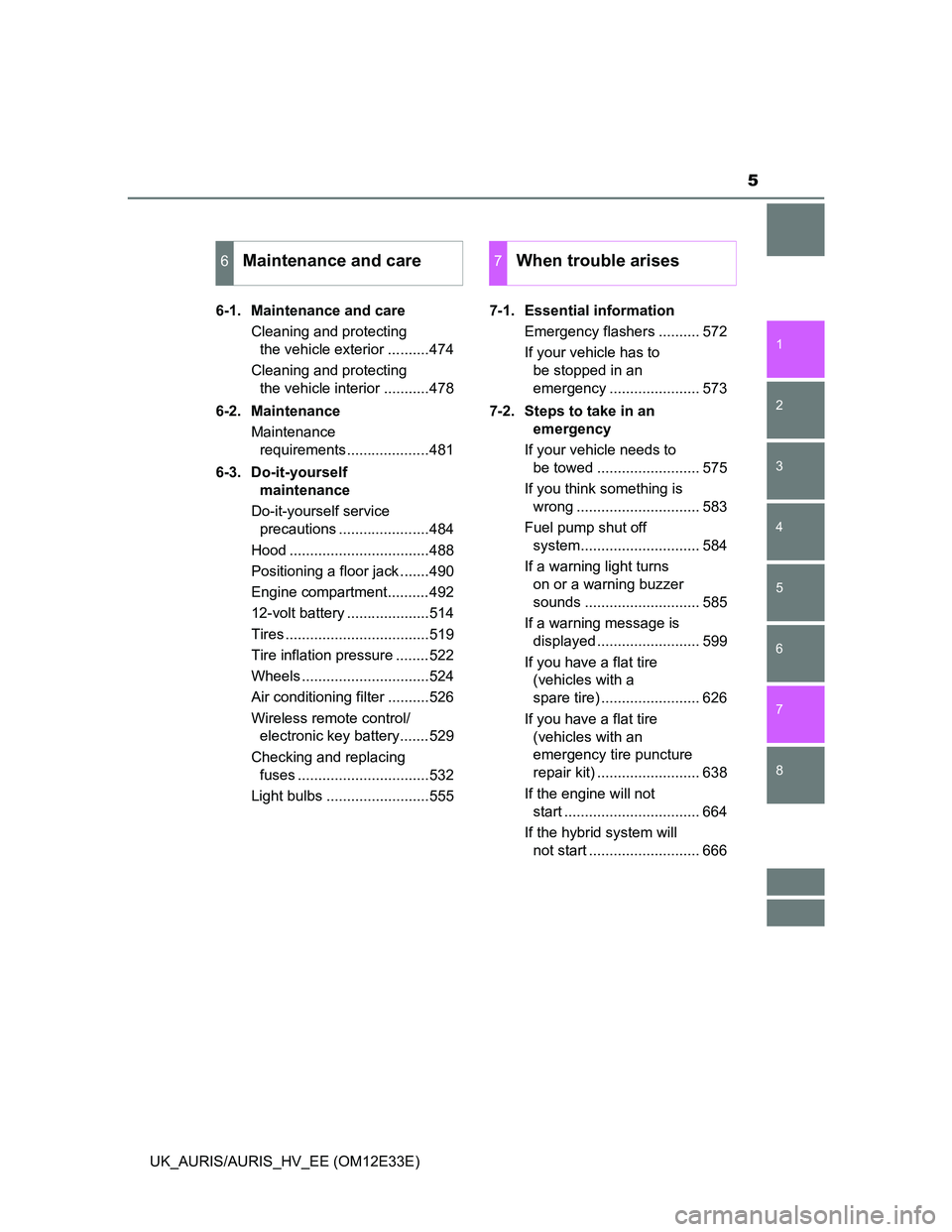
5
1
8 7
6
5
4
3
2
UK_AURIS/AURIS_HV_EE (OM12E33E)6-1. Maintenance and care
Cleaning and protecting
the vehicle exterior ..........474
Cleaning and protecting
the vehicle interior ...........478
6-2. Maintenance
Maintenance
requirements....................481
6-3. Do-it-yourself
maintenance
Do-it-yourself service
precautions ......................484
Hood ..................................488
Positioning a floor jack .......490
Engine compartment..........492
12-volt battery ....................514
Tires ...................................519
Tire inflation pressure ........522
Wheels ...............................524
Air conditioning filter ..........526
Wireless remote control/
electronic key battery.......529
Checking and replacing
fuses ................................532
Light bulbs .........................5557-1. Essential information
Emergency flashers .......... 572
If your vehicle has to
be stopped in an
emergency ...................... 573
7-2. Steps to take in an
emergency
If your vehicle needs to
be towed ......................... 575
If you think something is
wrong .............................. 583
Fuel pump shut off
system............................. 584
If a warning light turns
on or a warning buzzer
sounds ............................ 585
If a warning message is
displayed ......................... 599
If you have a flat tire
(vehicles with a
spare tire) ........................ 626
If you have a flat tire
(vehicles with an
emergency tire puncture
repair kit) ......................... 638
If the engine will not
start ................................. 664
If the hybrid system will
not start ........................... 666
6Maintenance and care7When trouble arises
Page 17 of 750
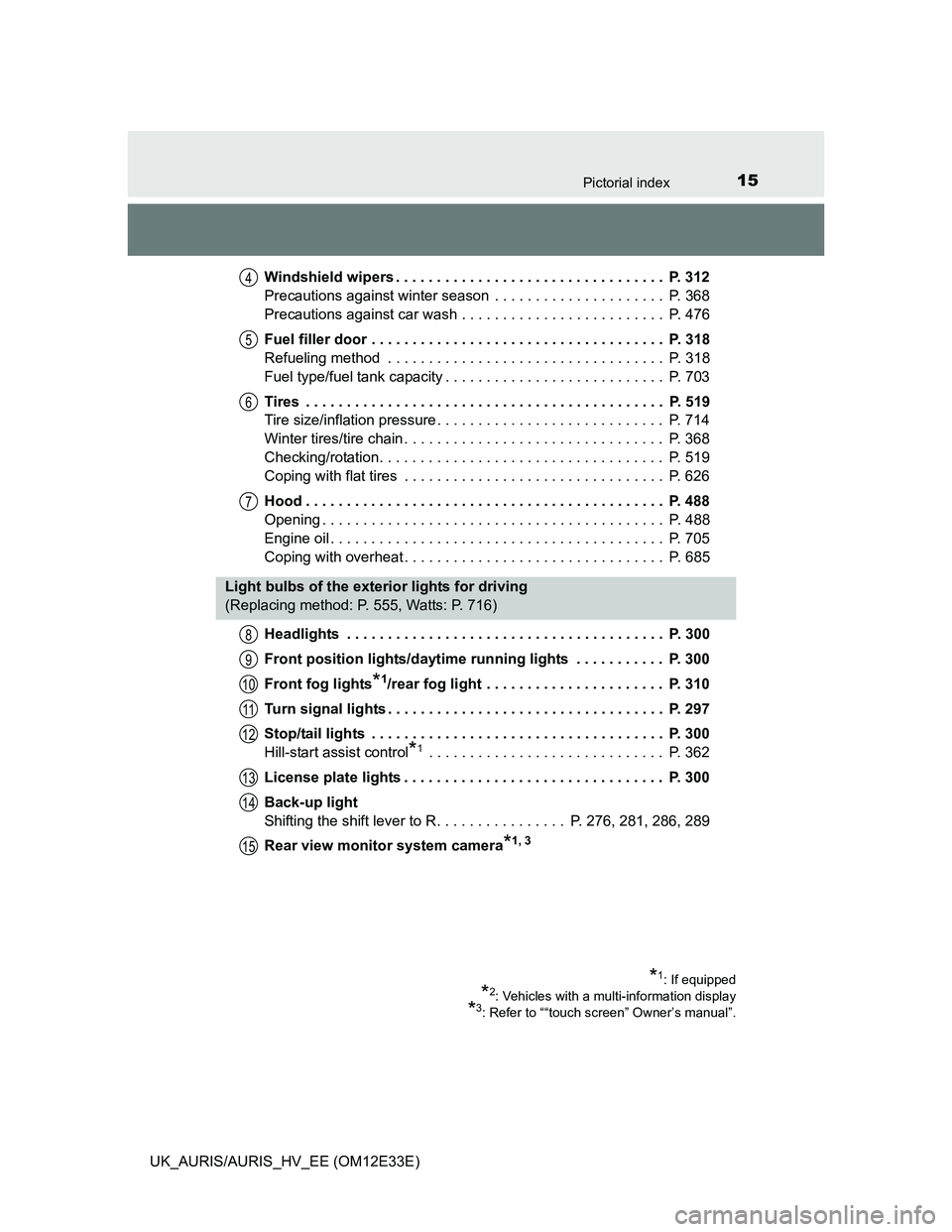
15Pictorial index
UK_AURIS/AURIS_HV_EE (OM12E33E)Windshield wipers . . . . . . . . . . . . . . . . . . . . . . . . . . . . . . . . . P. 312
Precautions against winter season . . . . . . . . . . . . . . . . . . . . . P. 368
Precautions against car wash . . . . . . . . . . . . . . . . . . . . . . . . . P. 476
Fuel filler door . . . . . . . . . . . . . . . . . . . . . . . . . . . . . . . . . . . . P. 318
Refueling method . . . . . . . . . . . . . . . . . . . . . . . . . . . . . . . . . . P. 318
Fuel type/fuel tank capacity . . . . . . . . . . . . . . . . . . . . . . . . . . . P. 703
Tires . . . . . . . . . . . . . . . . . . . . . . . . . . . . . . . . . . . . . . . . . . . . P. 519
Tire size/inflation pressure . . . . . . . . . . . . . . . . . . . . . . . . . . . . P. 714
Winter tires/tire chain . . . . . . . . . . . . . . . . . . . . . . . . . . . . . . . . P. 368
Checking/rotation. . . . . . . . . . . . . . . . . . . . . . . . . . . . . . . . . . . P. 519
Coping with flat tires . . . . . . . . . . . . . . . . . . . . . . . . . . . . . . . . P. 626
Hood . . . . . . . . . . . . . . . . . . . . . . . . . . . . . . . . . . . . . . . . . . . . P. 488
Opening . . . . . . . . . . . . . . . . . . . . . . . . . . . . . . . . . . . . . . . . . . P. 488
Engine oil . . . . . . . . . . . . . . . . . . . . . . . . . . . . . . . . . . . . . . . . . P. 705
Coping with overheat . . . . . . . . . . . . . . . . . . . . . . . . . . . . . . . . P. 685
Headlights . . . . . . . . . . . . . . . . . . . . . . . . . . . . . . . . . . . . . . . P. 300
Front position lights/daytime running lights . . . . . . . . . . . P. 300
Front fog lights
*1/rear fog light . . . . . . . . . . . . . . . . . . . . . . P. 310
Turn signal lights . . . . . . . . . . . . . . . . . . . . . . . . . . . . . . . . . . P. 297
Stop/tail lights . . . . . . . . . . . . . . . . . . . . . . . . . . . . . . . . . . . . P. 300
Hill-start assist control
*1 . . . . . . . . . . . . . . . . . . . . . . . . . . . . . P. 362
License plate lights . . . . . . . . . . . . . . . . . . . . . . . . . . . . . . . . P. 300
Back-up light
Shifting the shift lever to R. . . . . . . . . . . . . . . . P. 276, 281, 286, 289
Rear view monitor system camera
*1, 3
4
5
6
7
Light bulbs of the exterior lights for driving
(Replacing method: P. 555, Watts: P. 716)
*1: If equipped
*2: Vehicles with a multi-information display
*3: Refer to ““touch screen” Owner’s manual”.
8
9
10
11
12
13
14
15
Page 232 of 750
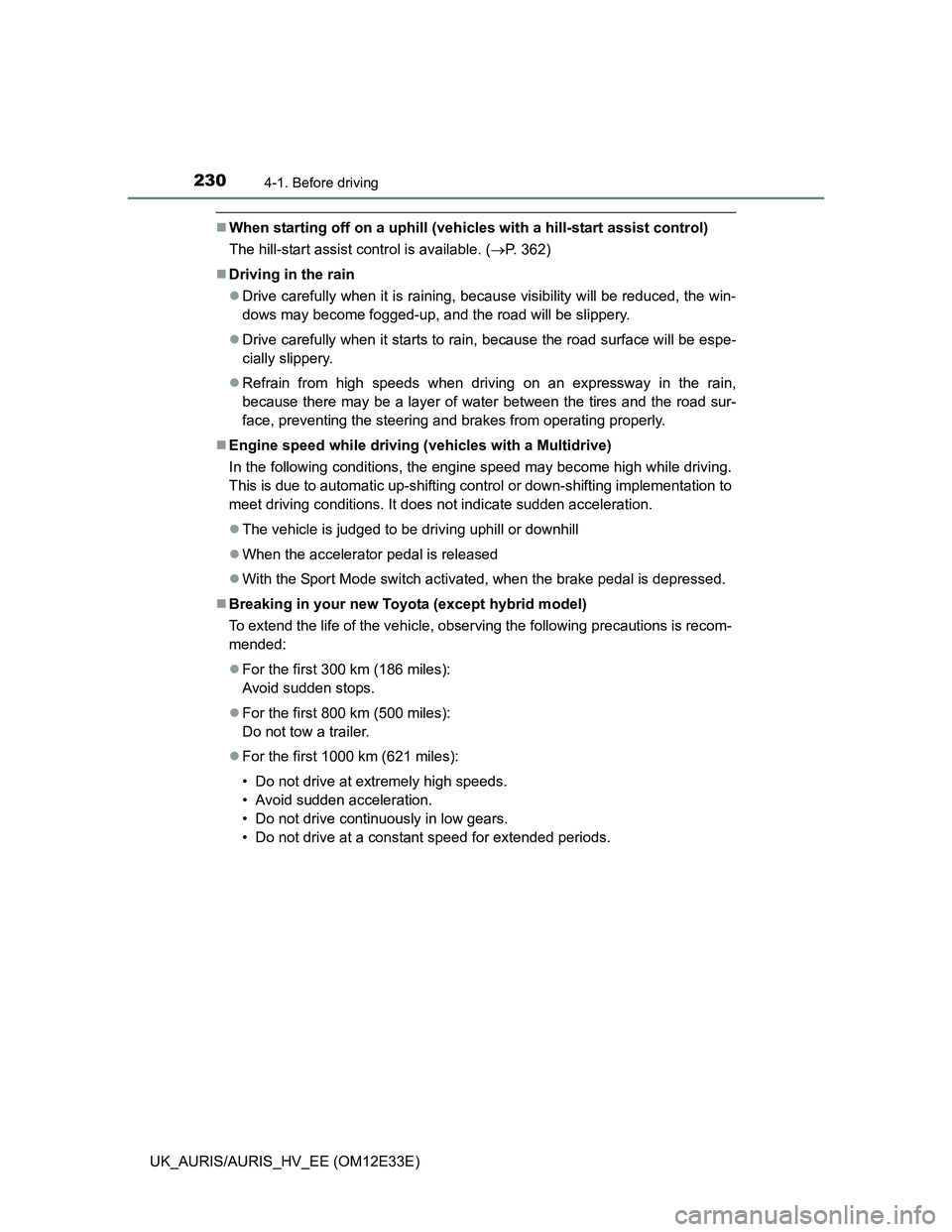
2304-1. Before driving
UK_AURIS/AURIS_HV_EE (OM12E33E)
When starting off on a uphill (vehicles with a hill-start assist control)
The hill-start assist control is available. (P. 362)
Driving in the rain
Drive carefully when it is raining, because visibility will be reduced, the win-
dows may become fogged-up, and the road will be slippery.
Drive carefully when it starts to rain, because the road surface will be espe-
cially slippery.
Refrain from high speeds when driving on an expressway in the rain,
because there may be a layer of water between the tires and the road sur-
face, preventing the steering and brakes from operating properly.
Engine speed while driving (vehicles with a Multidrive)
In the following conditions, the engine speed may become high while driving.
This is due to automatic up-shifting control or down-shifting implementation to
meet driving conditions. It does not indicate sudden acceleration.
The vehicle is judged to be driving uphill or downhill
When the accelerator pedal is released
With the Sport Mode switch activated, when the brake pedal is depressed.
Breaking in your new Toyota (except hybrid model)
To extend the life of the vehicle, observing the following precautions is recom-
mended:
For the first 300 km (186 miles):
Avoid sudden stops.
For the first 800 km (500 miles):
Do not tow a trailer.
For the first 1000 km (621 miles):
• Do not drive at extremely high speeds.
• Avoid sudden acceleration.
• Do not drive continuously in low gears.
• Do not drive at a constant speed for extended periods.
Page 251 of 750
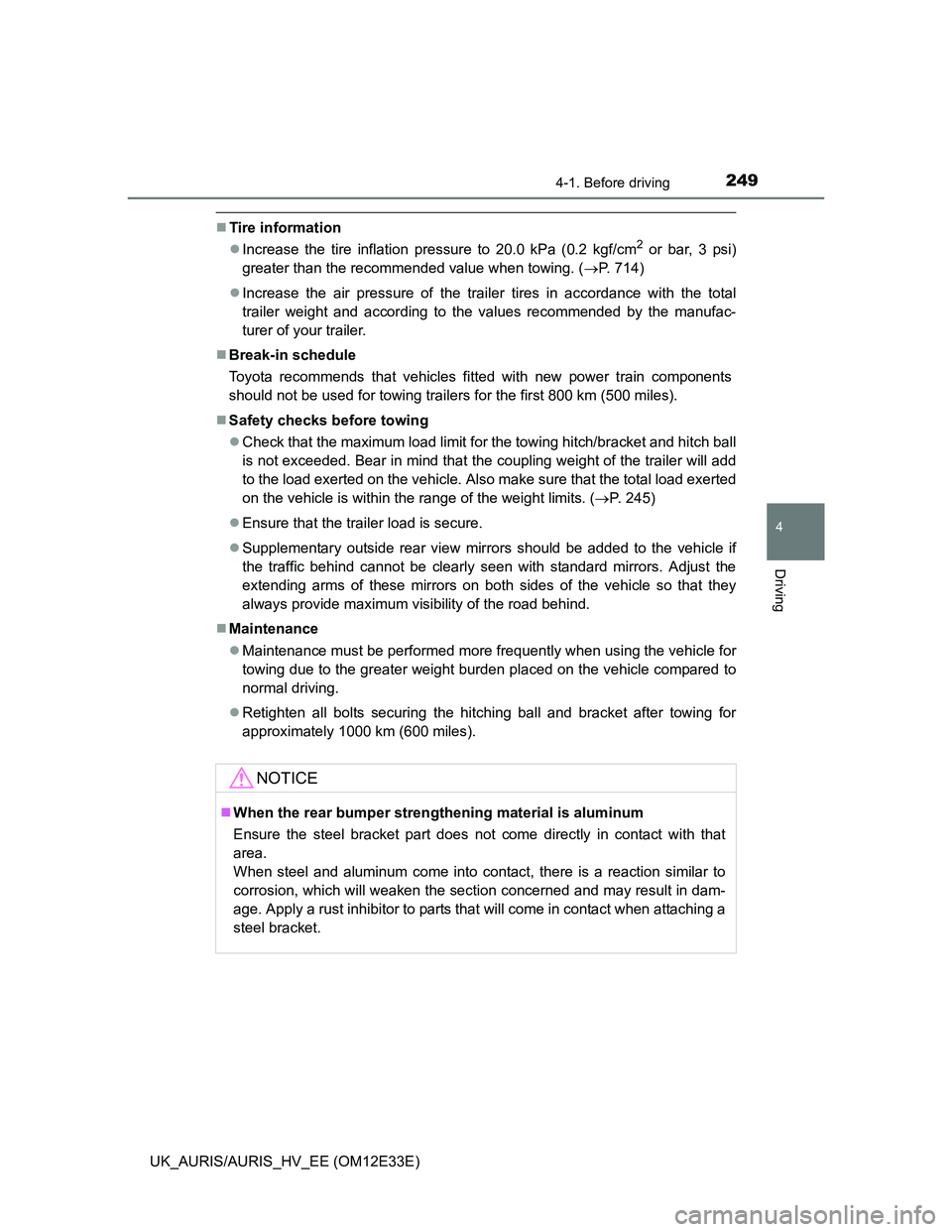
2494-1. Before driving
UK_AURIS/AURIS_HV_EE (OM12E33E)
4
Driving
Tire information
Increase the tire inflation pressure to 20.0 kPa (0.2 kgf/cm
2 or bar, 3 psi)
greater than the recommended value when towing. (P. 714)
Increase the air pressure of the trailer tires in accordance with the total
trailer weight and according to the values recommended by the manufac-
turer of your trailer.
Break-in schedule
Toyota recommends that vehicles fitted with new power train components
should not be used for towing trailers for the first 800 km (500 miles).
Safety checks before towing
Check that the maximum load limit for the towing hitch/bracket and hitch ball
is not exceeded. Bear in mind that the coupling weight of the trailer will add
to the load exerted on the vehicle. Also make sure that the total load exerted
on the vehicle is within the range of the weight limits. (P. 245)
Ensure that the trailer load is secure.
Supplementary outside rear view mirrors should be added to the vehicle if
the traffic behind cannot be clearly seen with standard mirrors. Adjust the
extending arms of these mirrors on both sides of the vehicle so that they
always provide maximum visibility of the road behind.
Maintenance
Maintenance must be performed more frequently when using the vehicle for
towing due to the greater weight burden placed on the vehicle compared to
normal driving.
Retighten all bolts securing the hitching ball and bracket after towing for
approximately 1000 km (600 miles).
NOTICE
When the rear bumper strengthening material is aluminum
Ensure the steel bracket part does not come directly in contact with that
area.
When steel and aluminum come into contact, there is a reaction similar to
corrosion, which will weaken the section concerned and may result in dam-
age. Apply a rust inhibitor to parts that will come in contact when attaching a
steel bracket.
Page 344 of 750

3424-5. Using the driving support systems
UK_AURIS/AURIS_HV_EE (OM12E33E)
When a message is shown on the multi-information display
MessageCauseWhat to do
“IPA SLOT NOT
DETECTED, SPEED
TOO HIGH”The vehicle speed
exceeded 30 km/h (18
mph).Reduce vehicle speed
to 30 km/h (18 mph) or
less.
“IPA CANCELED, TAKE
OVER”
The Simple-IPA switch
was turned off.Turn the Simple-IPA
switch on.
The Simple-IPA switch
was turned on while
reversing.Park the vehicle manu-
ally or detect another
parking space.
The shift lever was
shifted to R during
detection of a parking
space.Park the vehicle manu-
ally or detect another
parking space.
The shift lever was
shifted to a position
other than R during
automatic steering.Park the vehicle manu-
ally or detect another
parking space.
The steering wheel
could not be turned suf-
ficiently due to reasons
such as low tire pres-
sure, tire wear, the influ-
ence of road conditions,
being on a slope, etc.,
therefore the vehicle
could not be parked in
the desired space.
• Check tires for wear
and pressure.
• If this message is dis-
played when the vehi-
cle is parked in other
spaces, have the vehi-
cle inspected by any
authorized Toyota
dealer or repairer, or
another duly qualified
and equipped profes-
sional.
Page 350 of 750
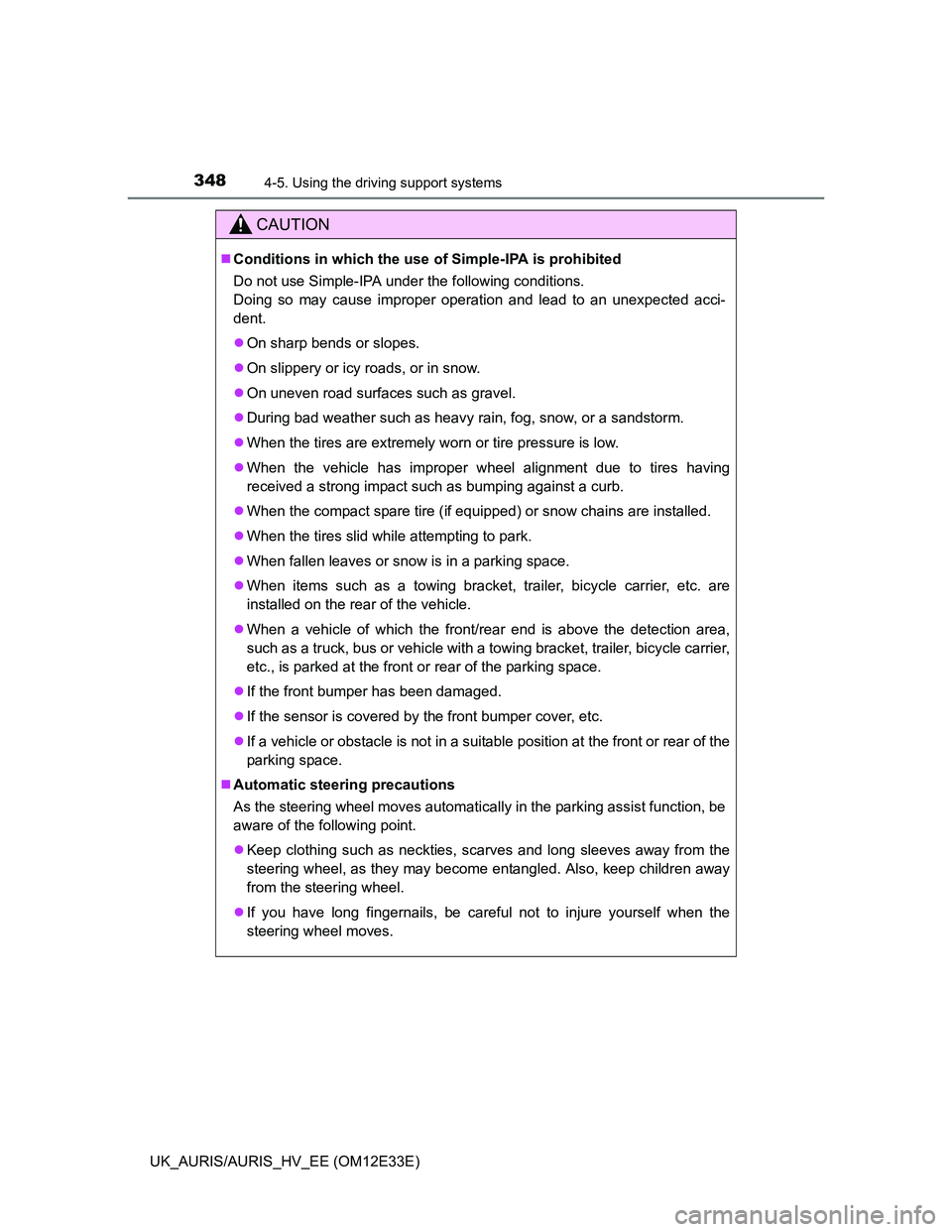
3484-5. Using the driving support systems
UK_AURIS/AURIS_HV_EE (OM12E33E)
CAUTION
Conditions in which the use of Simple-IPA is prohibited
Do not use Simple-IPA under the following conditions.
Doing so may cause improper operation and lead to an unexpected acci-
dent.
On sharp bends or slopes.
On slippery or icy roads, or in snow.
On uneven road surfaces such as gravel.
During bad weather such as heavy rain, fog, snow, or a sandstorm.
When the tires are extremely worn or tire pressure is low.
When the vehicle has improper wheel alignment due to tires having
received a strong impact such as bumping against a curb.
When the compact spare tire (if equipped) or snow chains are installed.
When the tires slid while attempting to park.
When fallen leaves or snow is in a parking space.
When items such as a towing bracket, trailer, bicycle carrier, etc. are
installed on the rear of the vehicle.
When a vehicle of which the front/rear end is above the detection area,
such as a truck, bus or vehicle with a towing bracket, trailer, bicycle carrier,
etc., is parked at the front or rear of the parking space.
If the front bumper has been damaged.
If the sensor is covered by the front bumper cover, etc.
If a vehicle or obstacle is not in a suitable position at the front or rear of the
parking space.
Automatic steering precautions
As the steering wheel moves automatically in the parking assist function, be
aware of the following point.
Keep clothing such as neckties, scarves and long sleeves away from the
steering wheel, as they may become entangled. Also, keep children away
from the steering wheel.
If you have long fingernails, be careful not to injure yourself when the
steering wheel moves.
Page 351 of 750
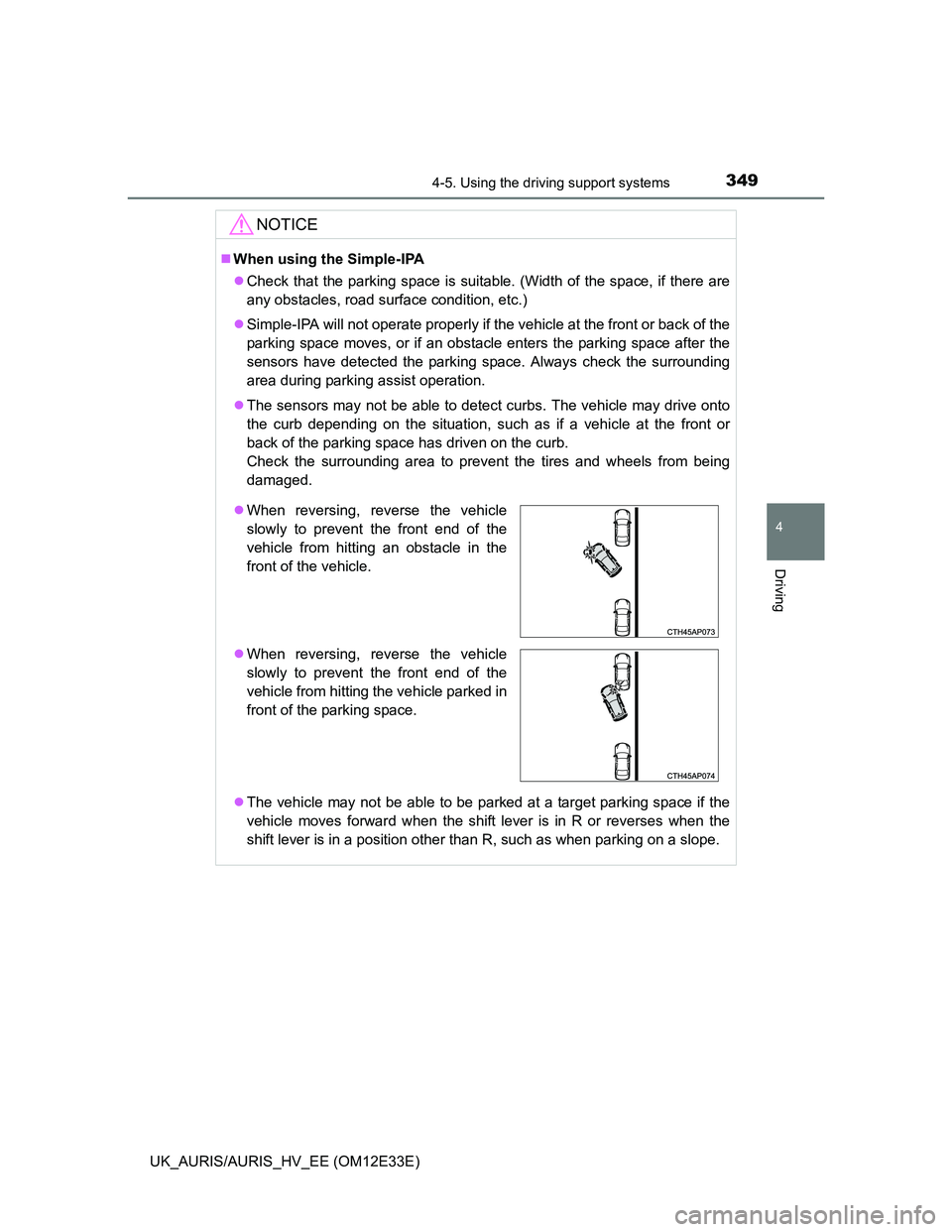
3494-5. Using the driving support systems
UK_AURIS/AURIS_HV_EE (OM12E33E)
4
Driving
NOTICE
When using the Simple-IPA
Check that the parking space is suitable. (Width of the space, if there are
any obstacles, road surface condition, etc.)
Simple-IPA will not operate properly if the vehicle at the front or back of the
parking space moves, or if an obstacle enters the parking space after the
sensors have detected the parking space. Always check the surrounding
area during parking assist operation.
The sensors may not be able to detect curbs. The vehicle may drive onto
the curb depending on the situation, such as if a vehicle at the front or
back of the parking space has driven on the curb.
Check the surrounding area to prevent the tires and wheels from being
damaged.
The vehicle may not be able to be parked at a target parking space if the
vehicle moves forward when the shift lever is in R or reverses when the
shift lever is in a position other than R, such as when parking on a slope.
When reversing, reverse the vehicle
slowly to prevent the front end of the
vehicle from hitting an obstacle in the
front of the vehicle.
When reversing, reverse the vehicle
slowly to prevent the front end of the
vehicle from hitting the vehicle parked in
front of the parking space.
Page 362 of 750
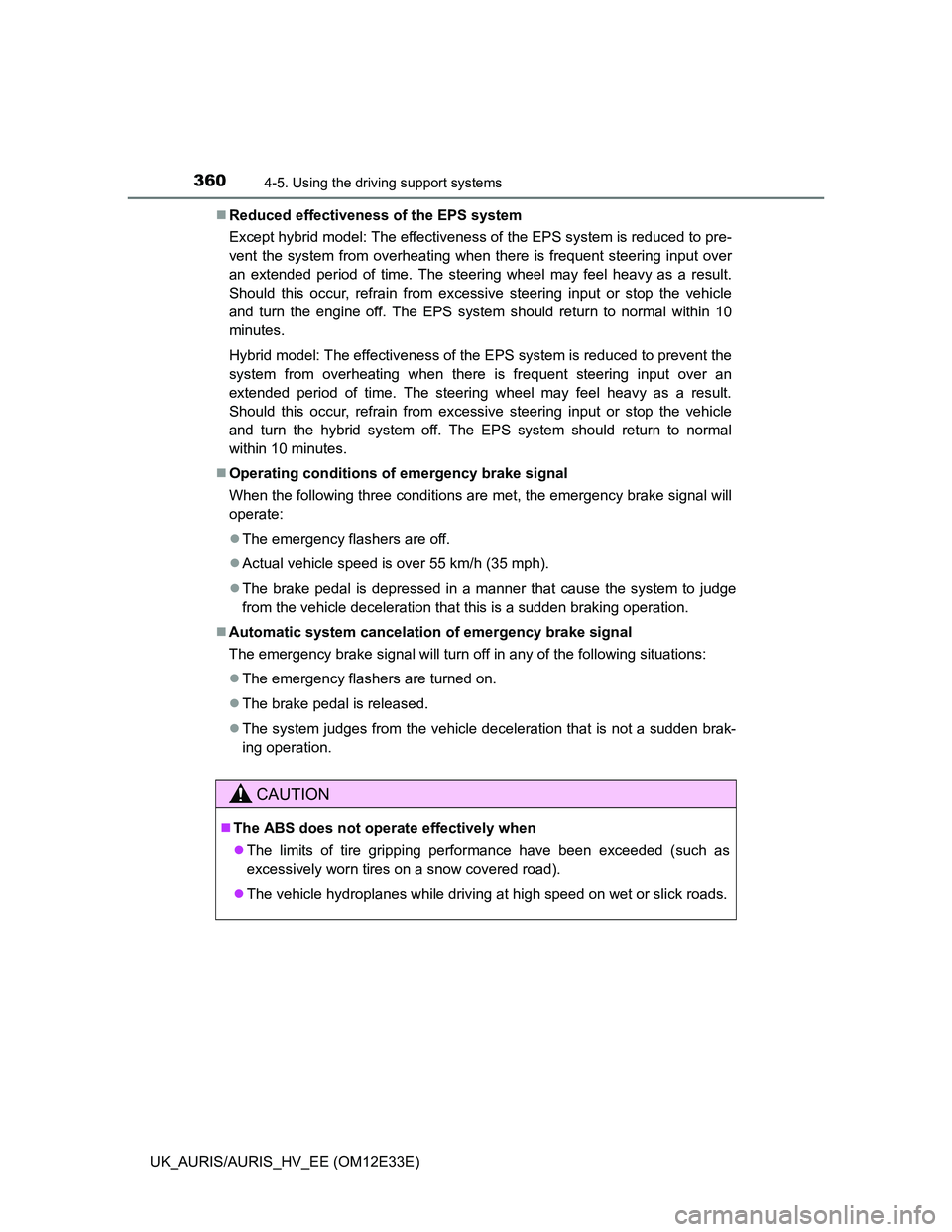
3604-5. Using the driving support systems
UK_AURIS/AURIS_HV_EE (OM12E33E)Reduced effectiveness of the EPS system
Except hybrid model: The effectiveness of the EPS system is reduced to pre-
vent the system from overheating when there is frequent steering input over
an extended period of time. The steering wheel may feel heavy as a result.
Should this occur, refrain from excessive steering input or stop the vehicle
and turn the engine off. The EPS system should return to normal within 10
minutes.
Hybrid model: The effectiveness of the EPS system is reduced to prevent the
system from overheating when there is frequent steering input over an
extended period of time. The steering wheel may feel heavy as a result.
Should this occur, refrain from excessive steering input or stop the vehicle
and turn the hybrid system off. The EPS system should return to normal
within 10 minutes.
Operating conditions of emergency brake signal
When the following three conditions are met, the emergency brake signal will
operate:
The emergency flashers are off.
Actual vehicle speed is over 55 km/h (35 mph).
The brake pedal is depressed in a manner that cause the system to judge
from the vehicle deceleration that this is a sudden braking operation.
Automatic system cancelation of emergency brake signal
The emergency brake signal will turn off in any of the following situations:
The emergency flashers are turned on.
The brake pedal is released.
The system judges from the vehicle deceleration that is not a sudden brak-
ing operation.
CAUTION
The ABS does not operate effectively when
The limits of tire gripping performance have been exceeded (such as
excessively worn tires on a snow covered road).
The vehicle hydroplanes while driving at high speed on wet or slick roads.
Page 363 of 750
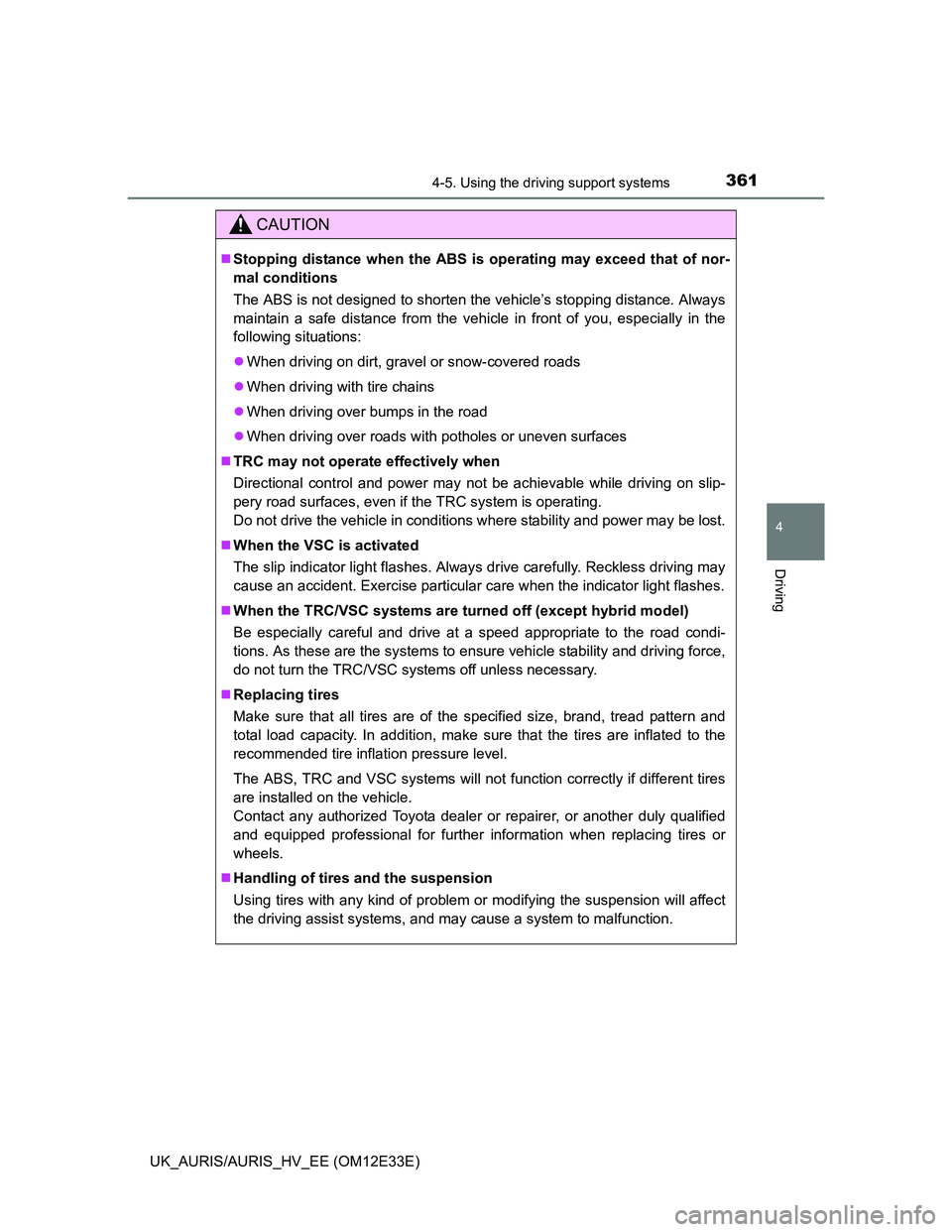
3614-5. Using the driving support systems
UK_AURIS/AURIS_HV_EE (OM12E33E)
4
Driving
CAUTION
Stopping distance when the ABS is operating may exceed that of nor-
mal conditions
The ABS is not designed to shorten the vehicle’s stopping distance. Always
maintain a safe distance from the vehicle in front of you, especially in the
following situations:
When driving on dirt, gravel or snow-covered roads
When driving with tire chains
When driving over bumps in the road
When driving over roads with potholes or uneven surfaces
TRC may not operate effectively when
Directional control and power may not be achievable while driving on slip-
pery road surfaces, even if the TRC system is operating.
Do not drive the vehicle in conditions where stability and power may be lost.
When the VSC is activated
The slip indicator light flashes. Always drive carefully. Reckless driving may
cause an accident. Exercise particular care when the indicator light flashes.
When the TRC/VSC systems are turned off (except hybrid model)
Be especially careful and drive at a speed appropriate to the road condi-
tions. As these are the systems to ensure vehicle stability and driving force,
do not turn the TRC/VSC systems off unless necessary.
Replacing tires
Make sure that all tires are of the specified size, brand, tread pattern and
total load capacity. In addition, make sure that the tires are inflated to the
recommended tire inflation pressure level.
The ABS, TRC and VSC systems will not function correctly if different tires
are installed on the vehicle.
Contact any authorized Toyota dealer or repairer, or another duly qualified
and equipped professional for further information when replacing tires or
wheels.
Handling of tires and the suspension
Using tires with any kind of problem or modifying the suspension will affect
the driving assist systems, and may cause a system to malfunction.
Page 369 of 750
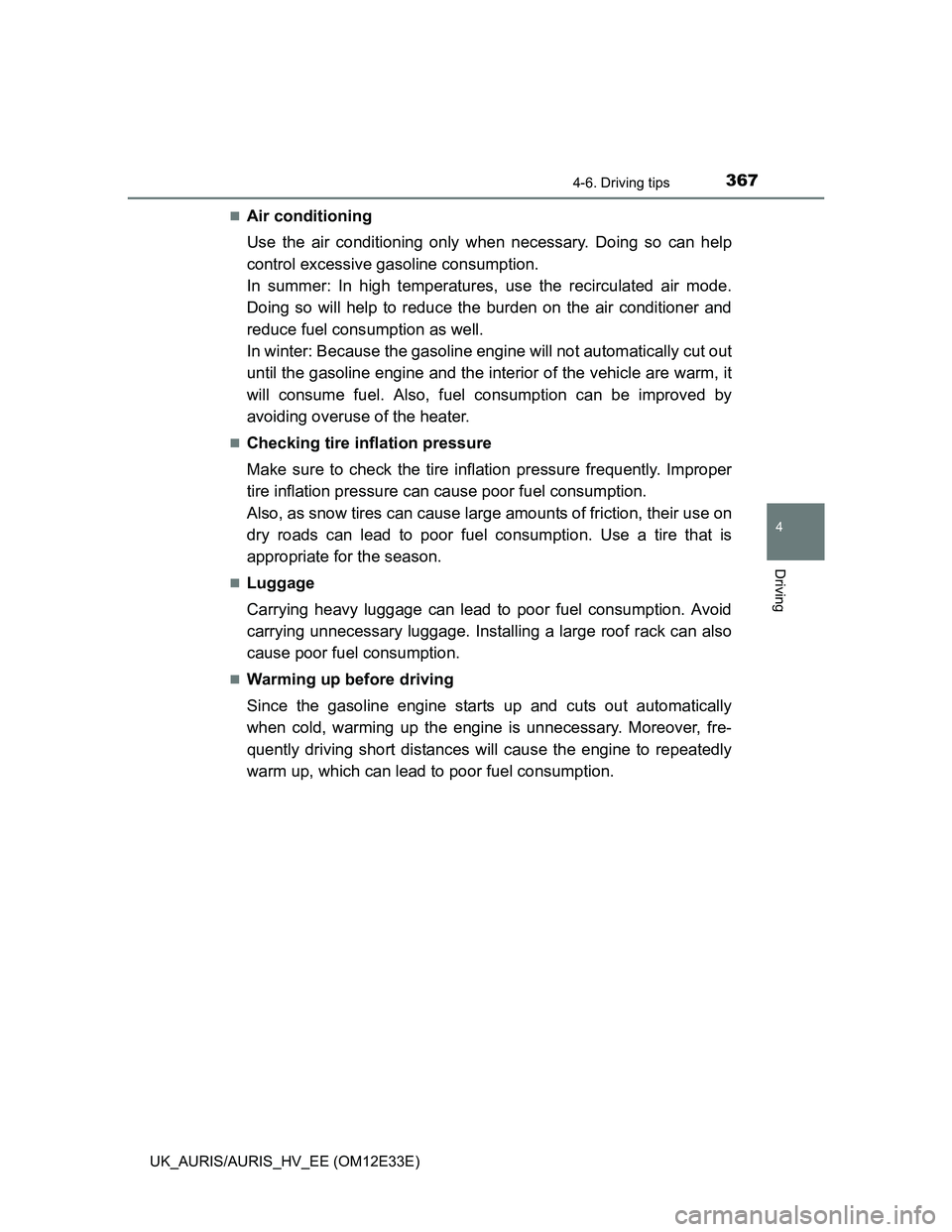
3674-6. Driving tips
UK_AURIS/AURIS_HV_EE (OM12E33E)
4
Driving
Air conditioning
Use the air conditioning only when necessary. Doing so can help
control excessive gasoline consumption.
In summer: In high temperatures, use the recirculated air mode.
Doing so will help to reduce the burden on the air conditioner and
reduce fuel consumption as well.
In winter: Because the gasoline engine will not automatically cut out
until the gasoline engine and the interior of the vehicle are warm, it
will consume fuel. Also, fuel consumption can be improved by
avoiding overuse of the heater.
Checking tire inflation pressure
Make sure to check the tire inflation pressure frequently. Improper
tire inflation pressure can cause poor fuel consumption.
Also, as snow tires can cause large amounts of friction, their use on
dry roads can lead to poor fuel consumption. Use a tire that is
appropriate for the season.
Luggage
Carrying heavy luggage can lead to poor fuel consumption. Avoid
carrying unnecessary luggage. Installing a large roof rack can also
cause poor fuel consumption.
Warming up before driving
Since the gasoline engine starts up and cuts out automatically
when cold, warming up the engine is unnecessary. Moreover, fre-
quently driving short distances will cause the engine to repeatedly
warm up, which can lead to poor fuel consumption.